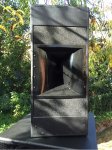Andy,
I think you get reflections from the ground during the measurement that may cause to (partially) cancel out some frequencies in the 3-400 Hz area. Which you are probably adding (or at least not removing) with the peqs.
I just put the speakers on a stick, measured them at different heights and angles at 2-3m distance. In REW I applied a time window of a couple of ms (I think it was 5-10ms) on the impulse response to get rid of parf of the reflections. I ended up with only 2 peq: 3-400 Hz -4dB and 3-3.5 kHz -4dB and it sounds quite good.
I also see that you have a peak in the HF. Did you use the passive filter? I did not have this peak with the passive filter.
My strategy at first is to only remove things that should not be there (resonances). First convince yourself by multiple measurements (different heights/distances) what should not be there and what is really missing. You can easily misjudge a single measurement, is what I learned.
Verzonden vanaf mijn iPhone met Tapatalk
I think you get reflections from the ground during the measurement that may cause to (partially) cancel out some frequencies in the 3-400 Hz area. Which you are probably adding (or at least not removing) with the peqs.
I just put the speakers on a stick, measured them at different heights and angles at 2-3m distance. In REW I applied a time window of a couple of ms (I think it was 5-10ms) on the impulse response to get rid of parf of the reflections. I ended up with only 2 peq: 3-400 Hz -4dB and 3-3.5 kHz -4dB and it sounds quite good.
I also see that you have a peak in the HF. Did you use the passive filter? I did not have this peak with the passive filter.
My strategy at first is to only remove things that should not be there (resonances). First convince yourself by multiple measurements (different heights/distances) what should not be there and what is really missing. You can easily misjudge a single measurement, is what I learned.
Verzonden vanaf mijn iPhone met Tapatalk
Last edited:




